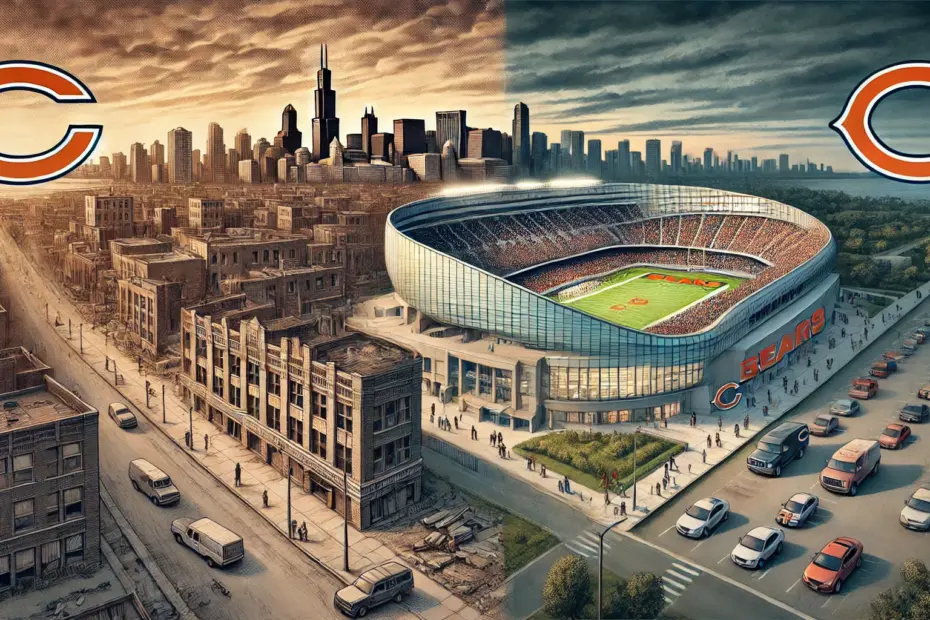As the debate over the Chicago Bears’ future home heats up, the public narrative has focused on stadium amenities, property taxes, and public funding. But the real issue, the elephant in the room that no one seems willing to address, is this: Suburban fans don’t feel safe coming into the city anymore.
For decades, Soldier Field has been home to the Bears and the loyal fans who make the trek into downtown Chicago for games. But for many suburban season ticket holders—the financial backbone of the franchise—those days are over. The reasons are as clear as they are unspoken: rising crime, leadership failures, and a downtown that feels abandoned.
The Gen Xers among us, who grew up watching Jim McMahon and Walter Payton bring glory to the field, remember a time when heading to Soldier Field wasn’t a safety gamble. But now? Many of us are saying, “Hard pass.”
Season Ticket Holders: The Real Stakeholders
Season ticket holders aren’t just fans—they’re investors. They’re the ones paying thousands of dollars for the privilege of cheering on the Bears, from the nosebleeds to the luxury suites. They’re the ones forking over $50 for parking and another $50 for overpriced beers and brats. In short, they’re the ones keeping the franchise afloat.
But when those same fans no longer feel safe driving into Chicago, the equation changes. This isn’t just about convenience—it’s about personal safety. For many suburban fans, the pandemic and the riots of 2020 were the breaking point. COVID-19 emptied the stands, and the civil unrest left a scar that hasn’t healed. The trust is gone, and for a lot of us, it’s not coming back.
The Stories the Evening News Won’t Cover
While local TV news might skim over crime statistics, outlets like CWBChicago lay it all out. They cover the grim reality of what’s happening in Chicago’s “safe” neighborhoods—the North Side, Lincoln Park, even downtown.
Take the Near North Side. Once a hotspot for upscale dining and entertainment, it now has a crime rate of 74.75 per 1,000 residents, making it one of the least safe neighborhoods in the country. Even traditionally quieter areas like Lake View have seen a surge in thefts. These aren’t just numbers—they’re reasons why suburbanites like myself stopped coming downtown years ago.
Leadership’s Role in the Decline
This isn’t just about crime—it’s about the lack of action that let crime flourish. During the riots of 2020, Chicago’s leadership stood by as businesses were looted and neighborhoods descended into chaos. That inaction empowered bad actors and sent a clear message: “We’re not prioritizing your safety.”
Now, those same leaders are asking fans to trust them to “fix” the problem. But for many of us, it’s too little, too late. Suburban fans—and the money they bring—have already left. The Bears, recognizing this shift, are simply following their audience.
Arlington Heights: A Ready-Made Solution
One of the biggest advantages Arlington Heights offers is its ready-to-go infrastructure. The site, formerly home to the Arlington Racetrack, already has a history of handling large crowds. For years, the racetrack welcomed thousands of visitors without issue, and the surrounding area is built to support that kind of traffic.
Located near Route 355, Arlington Heights is easily accessible via well-maintained tollways that are not only efficient but generate revenue for the state. Unlike the congested and often chaotic routes leading to Soldier Field, these suburban roads provide a smoother, safer journey for fans.
Driving to Arlington Heights doesn’t feel like a gamble—it’s a straightforward, safe, and predictable experience. Suburban fans don’t have to navigate crowded downtown streets or risk unsafe areas to reach their destination.
The site also requires minimal investment in new infrastructure. The existing road network can handle significant traffic, and any necessary improvements would be incremental—not a massive overhaul. Compare that to Soldier Field, where access has been a logistical nightmare for years, and the choice becomes even clearer.
The Gen X Perspective: Nostalgia Meets Reality
For those of us in Gen X, the irony isn’t lost. We grew up in the golden age of Bears football, back when Soldier Field was a symbol of Chicago pride. We remember the days of tailgating, when the biggest worry was whether you’d score tickets, not whether you’d make it home safely. But those days are gone.
Gen X isn’t naïve. We’ve watched the city change, and we know better than to buy into empty promises from leaders who’ve failed us time and again. Like the punk rock anthems we grew up with, we’ve learned to call out the BS when we see it—and the idea that fans will flock back to a “safer downtown” is just that: BS.
The Elephant in the Room
Here’s the ugly truth: The Bears are leaving because we—the suburban fans—already left. The riots, the crime, the lack of action—it all drove us away. And while Chicago leaders wring their hands about lost revenue and public funding, the reality is simple: You failed.
The Bears’ potential move to Arlington Heights isn’t just a business decision—it’s a survival strategy. They’re following the fans who made the franchise what it is, the fans who refuse to spend their money in a city that no longer feels safe.
So let’s stop pretending this is about tax breaks or stadium size. The Bears are leaving because Chicago abandoned its fans long before the fans abandoned Soldier Field. And until the city faces that truth, it will keep losing—businesses, residents, and yes, its beloved sports teams.
A Warning for Chicago
If Chicago doesn’t get its act together, the Bears will just be the beginning. The city’s decline isn’t just bad for fans—it’s bad for everyone. Arlington Heights is a wake-up call. Let’s hope someone’s listening.
